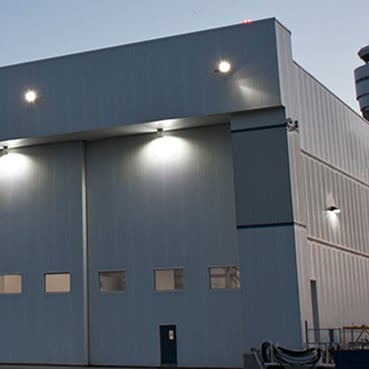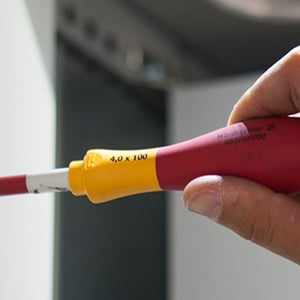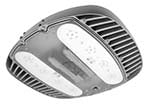From a lighting design perspective, it's crucial to consider the environment of the workplace. Especially when selecting LED high bay or low bay lights.
Lighting Design Perspective
From a lighting design perspective, it is easy to assume that a plant is a large, empty structure. This viewpoint allows the specification of ceiling-mounted or suspended lights. HazLoc and explosion proof models provide the correct spacing for target light levels. However, most facilities contain complex, extensive shelving and equipment. This requires operators to navigate tight spaces, walkways, platforms, etc. They must perform complex duties to maintain uninterrupted production.
Design concepts and reality often end up far apart from a lighting perspective. The lighting can fail to meet required light levels or human-centric best practices. Lights end up blocked, creating shadows. Also, preventing access in the future for service or upgrades.
It's crucial to consider the fully outfitted plant when selecting LED high bay or low bay lights. Projects can combine ceiling, wall, and equipment-mounted luminaires to deliver superior results.
Light Output and Beam Profile
 Considerations for high bay or low bay lights start with system lumen output. 5,000 - 15,000 lumen output models are often used as low bays for 12–20ft mounting heights. Higher output models starting at 18,000 lumens allow use at altitudes of over 20ft.
Considerations for high bay or low bay lights start with system lumen output. 5,000 - 15,000 lumen output models are often used as low bays for 12–20ft mounting heights. Higher output models starting at 18,000 lumens allow use at altitudes of over 20ft.
Beyond the lumen output value, considerations must weigh light beam profiles. Matching the distribution type with application details and mounting location is vital. For example, secondary optics with Type 5 deliver superior results for open spaces. These optics allow very low ratios between max and min light levels for even illumination. Type 3 reduces backlight on walls to push light toward the usable space. Type 1 is often used for aisle lighting, reducing consumption, and light spills.
Supplemental lighting locations are internal perimeter walls, short poles, and equipment. These areas need a proffered design approach for many facilities. These locales reduce the need for high bays. Moving lights to a more accessible location, improving visual quality and future serviceability.
Color Temperature and Color Rendering Index
Traditional HID fixtures offer limited options for color temperature and high CRI selection. Metal Halide bulbs within facilities provide "white" light, while HPS often flood the exterior with "orange" light. Improved lighting quality, visual comfort, and color representation are all available with LEDs.
4,000 - 5,000K color LEDs offer great options for indoor applications while providing high CRI options of 90+. This ability enables operators to conduct work while maintaining safety and accuracy. Exterior lighting choices are available in 3,000 - 5,000K, depending on the sensitivity of the surrounding environment. For dark sky compliance and reduced impact on flora and fauna, select 3,000K or lower options. Nemalux's catalog offers opportunities for all categories.
Controls for High Bay and Low Bay Fixtures
Motion and daylight sensors are common ways to increase energy efficiency. Explosion proof and hazardous location lighting strategies often use a zone-based approach. This blueprint allows the grouping of several lights within a single zone, controlled together. With this approach, contractors mount controls in small enclosures. They supply a control signal, such as 0-10V, to dim compatible power supplies.
Most LED fixtures are instant-on capable. Providing added flexibility and many ON/OFF cycles per day. Older HID fixtures with long warm-ups are not an ideal option for controls.
Close coordination is a must to ensure compliance with health and safety considerations. Since explosion proof and hazardous location rated areas have heightened safety needs. This aspect may overrule the desire to reduce power consumption.
Ingress Protection Levels for High Bay and Low Bay LED Lights
IP ratings show the level of protection against dust and moisture. Industrial facilities often experience a higher degree of contamination compared to commercial locations. The presence of contaminants and the need for intensive cleaning routines mandate a well-sealed luminaire for heavy industrial applications.
Specialized gaskets and other housing elements offer high bay and low bay lights with protection levels reaching IP66/67.
Dust and liquids accumulate inside commercial-grade lights in many processing facilities. This buildup reduces light output, creates unattractive appearances, and results in expensive maintenance tasks.
Consider the IP ratings of LED fixtures when selecting high bay and low bay lights. Ensuring suitability for the explosion proof or hazardous location environment they will illuminate.
Fixture Lead Time
Many suppliers often do not stock explosion-proof or hazardous location-rated lights. They remain a special-order item for most projects, independent of order quantities.
The availability of high bay and low bay explosion proof lights is an essential consideration for projects. Especially for a lighting installation with tight deadlines.
Prioritizing North American Made products avoids delays for lighting projects. These can be shipped from electrical distributors or drop-shipped directly to sites.
Future Upgrade and Serviceability
LEDs and their power supplies outlast conventional HID high bays by many years. Specifying and installing lights designed with long-lasting service in mind is essential. In case of explosion proof lights for hazardous location use, it is crucial to maintain the system for many decades. These systems are heavy-duty equipment, and operators wanting to maximize their positive impact. Upgrading aging light engines and power supplies offers a low-cost opportunity to extend system life.
Energy Rebates for LED High Bay and Low Bay Lights
Energy efficiency and extended system life make LED high and low bays a good option for industrial facilities. Hazardous locations that need explosion proof lights are also transitioning to LED models. This transition process is ongoing; some funds can come from rebate programs. These are specific to each area and should be identified before the project execution.
Rebate eligibility ensures access to incentives offered by utility companies. Considering the latest Design Lights Consortium (DLC) listings is essential. Power requirements, lumen output, and other specifications define eligibility levels for LED fixtures.
Checking with your utility company about rebate eligibility is advisable.
Collaborating with a lighting partner is vital for project success. They can assist in assessing options and refining a strategy. Delivering products that meet project goals and budgets and ensuring uninterrupted operations.
Mid-range fixtures may provide better long-term financial outcomes.
The expectation is to conduct a mock-up to test performance in existing facilities. Installing a group or row of fixtures allows us to gauge performance.


